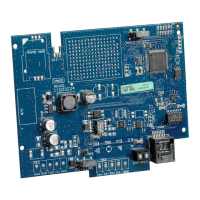What does yellow LED flashing 9 times mean on DSC neo TL280E?
- SScott HammondSep 12, 2025
If the yellow LED on your DSC Cell Phone flashes 9 times, it indicates an FTC trouble. Restart the system, if trouble persists, contact the dealer.

What does yellow LED flashing 9 times mean on DSC neo TL280E?
If the yellow LED on your DSC Cell Phone flashes 9 times, it indicates an FTC trouble. Restart the system, if trouble persists, contact the dealer.
What does yellow LED flashing 12 times mean on DSC Cell Phone?
If the yellow LED on your DSC Cell Phone flashes 12 times, it indicates a module configuration trouble. Ensure that a valid account code has been entered in these sections.
What does it mean if the green LEDs are alternating on my DSC neo TL280E Cell Phone?
If the green LEDs are alternating on your DSC Cell Phone, it may indicate a radio reset or radio initialization. If this status persists and the yellow LED shows 5 flashes, confirm that the SIM card is active.
| Brand | DSC |
|---|---|
| Model | neo TL280E |
| Category | Cell Phone |
| Language | English |
Installer's responsibility to inform users of system warnings.
Overview of common reasons for system failure, limitations, and potential compromises.
Alarms are not a substitute for insurance or prudent user actions.
Manual usage guidelines and critical safety instructions for installation.
Critical safety warning regarding installation during lightning storms.
List of models, their functions, and factors affecting cellular performance.
Confirming cellular network availability and signal strength before installation.
List of control panels compatible with the communicators.
Security features like encryption, redundant paths, and remote management.
Dual line security transmission and EN50131-1 installation requirements.
Technical ratings and compatible receivers/panels for the communicators.
Requirements for encryption and Ethernet connection setup.
Requirements for qualified installers and the installation environment.
Guidelines for installing Ethernet cables and managing SIM cards.
Connecting RS-232 cables and mounting the communicator in panels.
Detailed steps for assembling the mounting bracket and attaching the communicator.
Connecting the PC-LINK cable and antenna to the panel and communicator.
Diagram showing PC-Link, Antenna, and Screw locations on the panel.
Critical safety warning regarding power limited modules and wiring separation.
Steps to ensure SIM card is inserted and panel power is off before connection.
Routing the CAT 5 Ethernet cable and connecting to NID.
Labels and descriptions for components in the wiring diagram.
Minimum power requirements for DSC panels to operate the communicator.
Table detailing RS-232 pin connections between devices.
Steps for powering on and observing initialization LEDs.
Explanation of keypad display modes like Section-Toggle and HEX/Decimal.
Procedures for entering hexadecimal and ASCII characters.
Key panel sections and programming options for communicator setup.
Procedure to test cellular antenna location suitability and signal strength.
Table and instructions for programming communication paths.
Programming settings for communication formats and call directions.
Enabling DLS and verifying programmed paths before leaving site.
How communicator troubles appear on the keypad LCD and in the log.
How the yellow LED indicates troubles via coded flashes.
Table mapping yellow LED flashes to specific trouble conditions.
Descriptions of common troubles like supervision, SIM lock, cellular, and Ethernet issues.
Troubles related to receiver availability and supervision.
FTC, Module Configuration, and Boot Loader Failed troubles.
Behavior of the red LED indicating network connection status.
Interpretation of green and yellow LEDs for signal strength and related actions.
Meaning of red and green LEDs for Ethernet and cellular activity.
Causes and solutions for no power or no signal indications.
Causes and solutions for supervision, cellular, and Ethernet communication troubles.
Causes and solutions for receiver, FTC, and configuration troubles.
Causes and solutions for boot loader failure and initialization sequence.
Cause and solution for Red and Yellow LEDs flashing together during initialization.
Cause and solution for green LEDs flashing or alternating.
Warranty period, repair/replacement policy, exclusions, and procedures.
Legal agreement for software use, including license grant and limitations.
Software licensing, transfer, copyright, export, and legal clauses.
Modification, interference, wireless, and FCC/IC compliance statements.
Specific installation requirements for EN50131-1 compliance.
Backup power for IP communications and network security policies.
Notes for using private and public data networks securely.
Requirements for ULC and UL residential/commercial fire and burglary applications.
Using the communicator as primary or supplementary communication.
Using the communicator for dual line security transmission.
